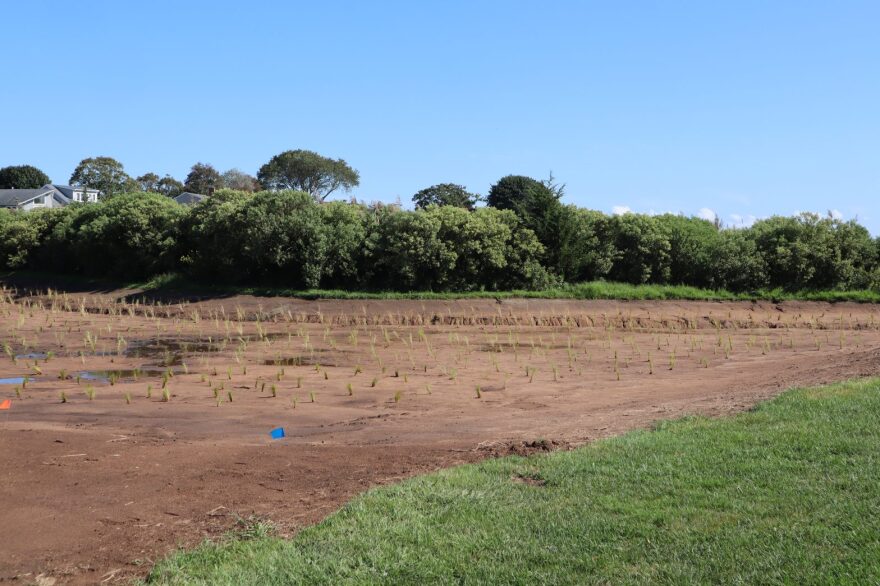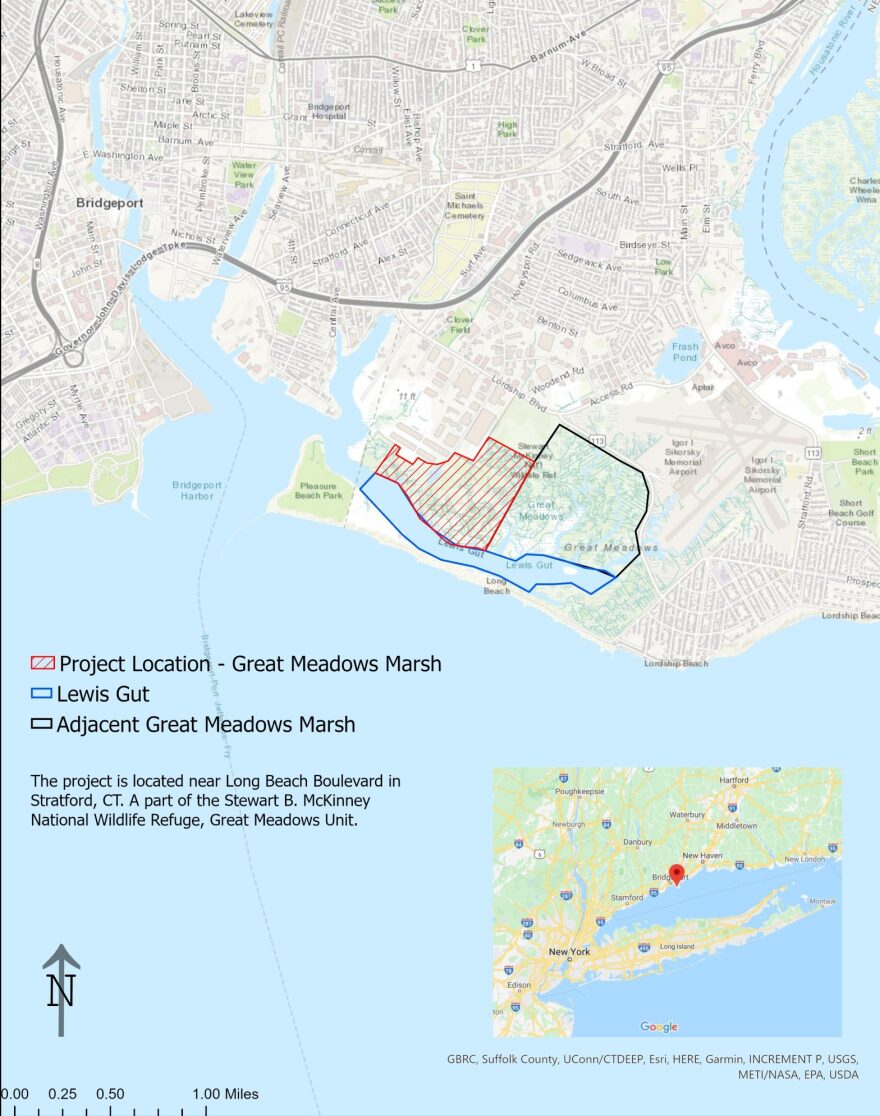It’s fitting that Paul Woodworth is tramping through rain and wind on a stormy September morning. That’s because what he wants to point out has everything to do with the effects of the weather on an otherwise scenic strip of beach in Guilford where the West River empties into Long Island Sound.
And indeed, as a lone great white heron stands guard — feet in the muck — it’s clear that water from the Sound has overrun marsh grass, sand and anything else in its way.
Woodworth points to a chunk of salt marsh that has broken off and is just lying at the edge of the shoreline.

“It’s just displaced and thrown up on the beach,” said Woodworth, who is the new ecological restoration senior project manager at Save the Sound, a New Haven-based environmental nonprofit.
Salt marsh is nature’s sponge. It soaks up water however it arrives. A marsh, left to its own devices, moves landward as water becomes too much of a constant for the marsh to survive where it is. That’s if there’s actually someplace it can move. Houses, roads and other kinds of infrastructure can block that movement and wind up flooded as a result.
This piece of land, known as the Chittenden area, has been taking a beating for more than a century. The salt marsh and land have eroded as rising sea levels, waves and storms pummel it from the Long Island Sound side and precipitation-fed floods overrun it from the other direction. The area does have roads and homes and other amenities of human habitation, so the marsh has gotten smaller, and flooding is worse.
“The salt marsh is getting undermined and eroded. It’s exposing sandier soils on these beaches,” Woodworth said. He points to a berm of sand and debris pushing into the marsh grass. “This is a leading edge of basically a sand ledge that’s getting pushed by wave energy into this salt marsh.”

Save the Sound wants to restore the marsh and keep it from eroding and flooding again. Along Connecticut’s shoreline, this sort of remediation is now more often being explored as a natural solution for the kind of flooding that is increasingly persistent due to climate change. But often it takes non-governmental action like this to do it.
Laura Wildman, Save the Sound’s vice president for ecological restoration, calls these marshes “life support systems.” They blunt the shoreline from waterborne impacts, and, by simply taking up space, they keep infrastructure farther back and out of harm’s way.
“These become our buffers like our sponges, or they dampen the effects of the storms. When they’re healthy, they can protect infrastructure further inland,” Wildman said. “When we’re talking about ecological restoration, we’re trying to get back to a more sustainable balance where our natural processes or natural ecosystems protect us.”
The Chittenden plan
There isn’t an exact one yet. Save the Sound has hired an engineering firm to come up with a specific design.
They’ve been using a not-implemented plan from about a decade ago as a starting point, though it may not become a final plan. The idea in that one was to put stone sills just offshore. These are underwater revetments — essentially walls made of boulders that allow water to flow through but act as a brake on wave energy. Onshore, the idea had been to backfill inundated areas with clean fill as a base to allow for marsh grasses to grow back, which they presumably would be able to do without water and waves tearing them apart as much. That in turn would stop the erosion and even help some of the land mass to build back.
But it’s way more than a matter of sticking new plants in the ground. Engineers will need to look at elevations in the water and on land, calculate wave energy and determine what the land and water can support without basically just swallowing up whatever they put there.
Even more difficult is to figure out what might happen in the future for factors like sea level rise, precipitation, intensity of storms and other elements that may arise due to climate change.
“Essentially, the analysis is to help determine if that concept really is going to hold up and really, if it makes sense,” Woodworth said.
In the meantime, the town is already doing some salt marsh planting at the edge of a park that borders a small part of the marsh on its land side. Janice Plaziak, Guilford’s town engineer, said it is designed to dovetail with whatever the updated Save the Sound project turns out to be.

“The one we’re doing is basically advancing the tidal marsh inland quicker than Mother Nature was,” Plaziak said.
Wildman warns that while the same body of water — Long Island Sound — is causing flooding problems up and down the coast, the solution is not one-size-fits-all. But the big issue in almost all cases is designing marsh restoration to be able to respond the way marshes are supposed to: filling with and flushing out water, and migrating as needed.
“One of the biggest things we can do in ecological restoration is just give the system enough room to respond,” Wildman said. “Are there ways we can move back infrastructure or decrease infrastructure right along the border, so the system can respond to it? Are there ways we can reestablish natural flow and sediment patterns to this system, so that it can sustain itself? Are there invasive vegetative species that we have to now go in and try and extract prior to being able to have the system restore itself? It’s really a wide variety of things.”
And time.
Great Meadows Marsh
The restoration of a 34-acre section of Great Meadows Marsh in Stratford, which is inside the Stewart B. McKinney National Wildlife Refuge, had been in the works for 15 years before it was finally done in the winter of 2021-2022.

Audubon Connecticut was the main force behind the project, which cost about $4.65-million, taking it on principally to restore the habitat of the salt marsh sparrow. Connecticut’s salt marshes are one of the bird’s main nesting locations in the world. The nests sit low in the marsh, however, putting populations under severe stress, if not threat of extinction, because of climate change-induced sea level rise.

That same rising water also contributes to flooding problems in the adjacent Sikorsky Field area of Stratford and homes nearby. The marsh had become “impounded” by dredge material from neighboring Bridgeport harbor that had been dumped there for years. That means the marsh was no longer getting flushed daily by tides. Instead the water was trapped, and as a result, mosquito populations had exploded.
“So it also was a public health issue,” said Jack Matthias, a coastal resilience associate at Audubon. “So we created channels, and we opened up areas that hadn’t seen tidal flow in a very long time.”
Even this short a time later, the Department of Energy and Environmental Protection reports, at least anecdotally, mosquito populations are down even in this rainy summer.

But the overall marsh restoration, which included building so-called hummocks – raised nest locations – for the salt marsh sparrows, will need more time to assess its overall success.
“The truth of the matter is, you don’t really know that for probably about 10 years,” Matthias said. At least in terms of the animals and natural functions of the area. He said the marsh plantings are already filling in and the channels are flowing nicely and water quality is improving, despite the difficult summer of flooding.
“One exciting thing is the salt marsh sparrow population that was already there. They haven’t started to use the hummocks, but they returned to the same area where the hummocks are, so the whole mix didn’t scare them away, which was a really kind of positive attribute to the project.”
But another stark reminder from Wildman at Save the Sound: “It took us a very long time, generations and generations, to get to a lack of sustainability. It will take us generations to get back to a more sustainable spot.”


